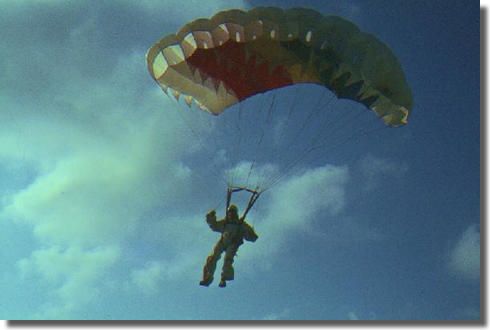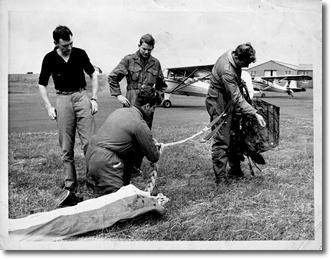|
'The Scotsman' newspaper, April 8th 2000 Reproduced courtesy of Felicity Martin
On 10 April 1960, Charles Robertson
clambered out of the passenger cockpit of a Tiger Moth over Perth Aerodrome at
Scone and launched himself into thin air. A few seconds later he pulled his
ripcord and descended safely on an army-surplus round parachute, a C9. His jump,
the first parachute descent in Scotland for fun, marked the birth of the
Scottish Parachute Club, which this week enjoys its 40th anniversary. As the oldest active parachute club in
Britain the Scottish Parachute Club has plenty to celebrate. It's unique in
being the only club that still belongs its to members rather than being a
privately-owned business. Moreover it has managed to keep operating for 40 years
despite the vagaries of Scottish weather, ever more stringent safety regulations
and the escalating costs of getting airborne. Its endurance depends partly on
the obsessional nature of the activity; once hooked parachutists will hang
around for days waiting for their adrenaline buzz. But, it also owes its
continued existence to the dedicated individuals who have steered it through
highs and lows, helping others to enjoy the freedom of the air. 'Doc' Robertson, as he was better known, developed
the parachuting bug when posted as a RAF medical officer to the Parachute School
at Abingdon. After his National Service he worked as a GP in Glasgow, returning
"with four parachutes, much enthusiasm and some ignorance." He
persuaded instructors from Abingdon to visit Scone and train the first two
courses in 1960. Bob Thompson joined during the second course in September. A
veteran of 56 military descents, 34 without a reserve - in the pre 1956 days
when the British Army deemed them unnecessary - he was allowed to jump without
further training. His first jump with the club, from a De Havilland Rapide
bi-plane, was also his first freefall. "I climbed on to lower wing,
stepping on a plate that stopped you going through the fabric," he recalls.
"I held on to wing strut with my left hand and crossed my right over my
chest to hold the ripcord. When the instructor said 'go' I jumped off backwards,
trying to stay stable, counted to three and pulled the ripcord."
small group of stalwarts shared facilities at
Perth Aerodrome with various flying activities until 1963 when the airfield
became too busy. In the following couple of years Doc Robertson lead the
Scottish Parachute Club to airfields at Carlisle and Glenrothes, before it
settled at Strathallan Castle, near Auchterarder. Sport Parachute magazine
reported that "the flying for parachute drops was done from what could
excusably have been mistaken for the castle lawn." Fortunately the club had
the use of a short take-off and landing aircraft, a Helio Courier, which was
able to throttle back to 55mph flying speed when the parachutists exited. The
first drop, by three instructors, one wearing a smoke canister, caused some
consternation among locals. Police followed up a report that "an aircraft
had been seen in trouble with its engine stopped; three people had baled out,
one with his leg on fire." The next year Sir William Robertson, who owned
Strathallan Castle, built an airstrip and began his famous aircraft collection.
For a period the airfield was a hive of activity, with aircraft maintenance and
restoration, freight transportation and passenger flights bound for nearby
Gleneagles Hotel. In those days the parachute aircraft dropped jumpers over the
moor behind Gleneagles - an empty stretch of heather where the only hazard was
landing on the wildlife. On one occasion the glorious twelfth was celebrated by
an instructor jumping on to the lawn of Gleneagles Hotel with a brace of grouse
(which had been shot in the conventional manner) stuffed down his jumpsuit. In 1965 the club's founder Doc Robertson emigrated to
Nova Scotia. Fortunately Tom Dickson, who had become an instructor in 1963,
stepped into the breach as chairman and ably lead the club for many years. Both
men died prematurely during the 1980s, but their names remain legendary among
parachutists. Their commitment kept the club going and growing. Gordon Fernie, who joined the Scottish Parachute Club
in 1965, remembers the challenges of progressing as a student in the early days.
"You needed an aircraft, pilot, instructor and good weather - trying to get
all four together was almost impossible." Initially parachutists simply
fell on their own for the whole jump; it took a while for the idea of joining
together to evolve. "I remember two 'experienced' jumpers going up to
12,000 feet to do a link up," says Fernie. "But they never saw each
other - they left separately and by the time they were stable and orientated
they had to pull." By 1975, when club instructor Billy Sommerville
started parachuting, the art of relative work - moving through the sky in
relation to each other - was beginning to develop beyond simply holding hands in
freefall. "The late 1970s was the most innovative period," he recalls.
"Mark Conrad and Jack Gregory, big names from the States, came over and
told us we could let go and create other formations. Until then we'd been
building a 4-way and holding it until break-off. They also taught us to leave
the plane linked so that we had more time together." Somerville has seen
the speed and level of learning increase greatly. "Now a student has to
build four formations on a 4-way jump for their final qualification. In 1977 you
were considered a very good parachutist if could achieve that." During the
past decade, new forms of aerial play have begun to take over from making
formations and club members frequently fly in a sitting position or head-down.
But the same excitement still exists in climbing above fields, rivers and
mountains then leaping into space to freefall past the clouds. The most visible developments have been in equipment.
Gone are the enormous rigs that looked so unwieldy; the kit is smaller and
experienced jumpers use a tandem system, wearing both main and reserve
parachutes in a pack contoured to their backs. Instead of drab military surplus
parachutes, the sky is filled with a riot of colour. Small square chutes zip
around at great speed, while beginners use steerable round canopies, designed to
land more softly than the old C9s. Nowadays many more people parachute, partly because
of the need to attract more first-timers who provide the main income for the
club. Kieran Brady, who has been chairman for the past
13 years, acknowledges the trend. "Regrettably it's changed from a small
homely club into more of a commercial enterprise. What's brought it about is the
pressure to survive, the need to cover the rent, maintain the aircraft and pay
the chief instructor a salary. You either move with the times or fold." It looks as if the club's 40th
birthday celebrations will be progressive rather than backward looking. Fernie,
who, for the 21st anniversary, recreated the Doc Robertson's first
descent by jumping out of the original Tiger Moth over Scone, had planned to
repeat the exercise. Unfortunately the plane crashed last year. Instead Brady is
hoping 2000 will see a new record for the club - a 40-way link up over
Strathallan. Note : Felicity Martin used to be an instructor at the
Scottish Parachute Club. She did about 1800 jumps over 17 years and took part in
world record formations. Factfile The
Scottish Parachute Club operates at weekends from: Strathallan
Airfield (01764)
662572 Enquiries
to Karen Farr, the Club Chief Instructor, on (0374) 686161 Static line
Automatic opening system traditionally used for the
first few jumps. The static line is clipped into the aircraft and pulls the
parachute out of the backpack as the student falls away. The parachute, which is
usually round, is open within two to three seconds. Ram Air Progression
System (RAPS)
Equipment and training that allows students to use
ram air, or square, parachutes from their first static line jump, like more
experienced parachutists. This allows them to jump in stronger winds and avoids
later conversion training. Freefall
A jump where the parachutist falls through the air
before opening their parachute with a ripcord (for students) or hand-deployed
pilot chute (for experienced skydivers). The greater the exit altitude the
longer the delay possible, e.g. 60 seconds from 12,000 feet. Accelerated
Freefall
An intensive method of teaching skydiving in a few
jumps. The student starts with a long freefall delay accompanied by two
instructors and very quickly learns to control his or her movements in the air. Tandem
A way to enjoy the thrill of skydiving with very little training. The novice is strapped to the front of an instructor who controls proceedings. They make a freefall jump, often accompanied by a cameraman, then have a long descent under an extra large parachute. |

